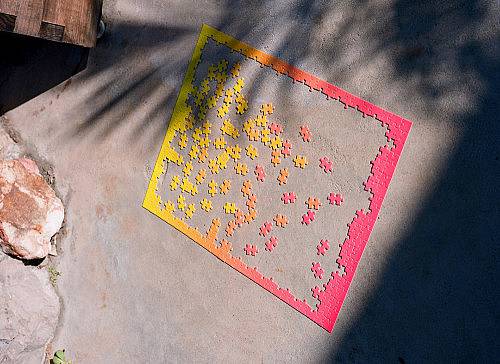Bryce Wilner is a designer in the Design, Publishing, and New Media department at the Museum of Contemporary Art Chicago.

Tell us a little bit about yourself and what you do. I work as a designer in the Design, Publishing, and New Media department at the Museum of Contemporary Art Chicago. As a department, we design exhibitions, publications, marketing materials, and anything else an art museum needs to produce on a regular basis. I also design typefaces, publications, and objects on my own.

What are some recent, upcoming or current projects you are working on? With Dylan Fracareta, I designed the exhibition graphics and collateral for The Freedom Principle: Experiments in Art and Music, 1965 to Now, which opened on July 11, 2015 at the MCA. The exhibition surveys the output of the Chicago-based jazz organization the Association for the Advancement of Creative Musicians (AACM) and follows its influence on contemporary art from the mid-1960s to 2015. It was curated by Naomi Beckwith and Dieter Roelstraete with Grace Deveney and Karsten Lund.
I recently founded mysterylibrary.org, a humble online catalogue of fictional books within works of fiction. I made some library cards to give away so that people can learn about it. The cards bear the words “Mystery Library is always inspecting new material for its catalogue.”And I’ve been collaborating with my brother Brandon—a writer and editor—on research concerning writers who use graphic design as a generative device in their work. On July 19, I presented a selection of this material in a lecture format at LVL3 Gallery.

How did your interest in art or design begin? I really liked to copy comic book drawings when I was young. My first published work came when I began illustrating my family’s holiday card in early elementary school. I suspect that this is the case for many designers working today.
What products or companies are you interested in right now? I use a research website called Are.na to index texts, images, audio, videos, and links. It’s hugely helpful for organizational purposes, but what I enjoy most about it is seeing what other people are aggregating and how it overlaps and intersects with my own activity. A few of my favorite channels on the site right now are called Abstract Mascots, Cool Punctuation, Deep Signs, Wild Animals vs. Manmade Materials, and Yuppie Dystopia.

What materials do you use in your work and what is your process like? I like to see how much I can pull out of the conditions inherent to the project at hand before I begin to add anything. This generally means that I’ll begin by writing as an attempt to collect all of the variables in my head. I’ve also heard that a good way to get ideas is to lie on the floor and do nothing.

Tell us a joke. Whenever I wash my dish drainer I have nowhere for it to dry.
What was the last show you saw that stuck out to you? Last month I had the chance to see Frances Stark’s feature-length film My Best Thing in a theater setting. Its dialogue is a direct transcript of Stark’s experiences being intimate with Italian men in sex chat rooms. The viewer follows along with the artist as she conceives and then performs the film you’re watching, but it’s also full of tangents about sex, creative intent, and narrative construction. I think about it very often.
What is your snack/beverage of choice when working in your studio? I like to drink tea throughout the day. Right now I have a bag of apricots in my desk drawer.
 Can you share one of the best or worst reactions you have gotten as a result of your work? Working in a museum where much of my design work is on display in an ambient way is nice because I can walk around the building and see people interacting with it at nearly any time. I once saw two children play-sword-fighting on the MCA’s plaza using rolled-up posters I designed.
Can you share one of the best or worst reactions you have gotten as a result of your work? Working in a museum where much of my design work is on display in an ambient way is nice because I can walk around the building and see people interacting with it at nearly any time. I once saw two children play-sword-fighting on the MCA’s plaza using rolled-up posters I designed.
What are you really excited about right now? Blue Cross Blue Shield has a 57-story office facility overlooking Lake Michigan. Occasionally, the electricians there create a pixel typeface on the broad side of their building by lighting up specific offices and darkening others. They use this system to send messages to the people of downtown Chicago. I read recently that the electrician who originated this tradition at BCBS was named Chris. The night he passed away, his colleagues lit up the windows with the words “THANKS CHRIS”, creating the impression that the building itself was eulogizing the human who cared for its electricity.

